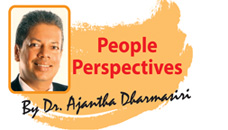Defining HRM for Sri Lanka
 There is a growing awareness and enthusiasm on people management in
Sri Lankan organisations. This is evident by the increasing number of
activities related to Human Resource Management (HRM) taking place on
many fronts. There is a growing awareness and enthusiasm on people management in
Sri Lankan organisations. This is evident by the increasing number of
activities related to Human Resource Management (HRM) taking place on
many fronts.
Yet, we have a long way to go in unleashing the true potential of our
productive workforce, in the wake of economic expansion and the
development drive. One key element in such an endeavour is to have
clarity of what HRM is all about.
We see hundreds of different ways of describing HRM. Some are
oversimplistic while some others are highly scholastic. What could be
the best way to approach HRM in defining it related to local needs?
A think tank from the Institute of Personnel Management (IPM) took
the initiative of developing a suitable definition of HRM for Sri Lanka.
This move is significant as IPM being the pioneering and premier HR
institute in Sri Lanka, moves towards a Charter status.
Best fit
Our approach was specific and straightforward. We looked at what was
available in terms of HRM definitions, identified key salient points and
listed them and brainstormed its relevance to Sri Lanka.
That was one aspect. On the other hand, we also brainstormed on how
to accommodate the socio-cultural and religio-political dimensions
influencing management practices in Sri Lanka. Our aim was to find the
best fit.
Based on the brainstorming session we had as a team and feedback
obtained from professionals and professors, the following definition
emerged.
 A strategic and integrated approach in acquisition, development and
engagement of talent, using relevant tools, with proper policies,
practices and processes in creating a conducive climate to achieve
organisational excellence and societal well-being (IPM, 2014). A strategic and integrated approach in acquisition, development and
engagement of talent, using relevant tools, with proper policies,
practices and processes in creating a conducive climate to achieve
organisational excellence and societal well-being (IPM, 2014).
What we meant by 'strategic' is working towards achieving overall
goals and specific objectives of the organisation. It is essentially
aligning with the broad organisational priorities.
It highlights the strategic significance of HRM and the holistic role
it should play. 'Talent' refers to three Cs going in line with Ulrich
(2009)- competence, commitment and contribution.
He in fact puts it as an equation. Talent = Competence x Commitment x
Contribution.
The multiplication sign in the equation symbolises the collaborator
and combined nature of the three vital aspects. 'Competence' essentially
refers to the knowledge (head), commitment refers to action (hands) and
contribution is related values (heart).
What we do with talent occupies a significant segment of our
definition.
Techniques
Acquisition refers to hiring (recruitment, selection and placement).
Engagement means a range of aspects such as involvement, attachment and
extra effort.
There is a reference to the term 'relevant tools' in our definition.
What we meant was to incorporate testing methods and assessment
techniques which should be linked to organisational needs.
We consciously included the term 'conducive climate' in our HRM
definition.
This means a supportive environment within the organisation. HR has a
critical role to play in creating such a climate. Climate refers to
those aspects of the environment that are consciously perceived by
organisational members.
Perception is essentially an understanding based on the information
obtained by senses such as eyes and ears. Hence, climate is something
people see, hear and feel.
Culture
That is why we see a difference when we enter a hospital, police
station or a restaurant. In summary, climate is what we see and feel
when we enter an organisation, whereas, culture is something much
deeper.
The end result of all HR endeavours has twin aspects, organisational
excellence and societal well-being. What we mean by organisational
excellence is its overall performance with continuous improvement.
It obviously, includes financial results, customer satisfaction,
process efficiency and people development, the four perspectives of a
typical balanced scorecard.
HR professionals cannot function in isolation ignoring social
realities. This is more relevant to a developing country such as ours,
where issues such as poverty, unemployment and ethnic tensions cannot be
ignored. That's why we included societal well-being as a key outcome of
HRM. It highlights the need to support people outside the organisation
and protect the environment as well.
Defining HRM clearly was one step towards delivering sustained
results. We need to put the act together, in ensuring the awareness,
appreciation and application among Sri Lankan HR professionals.
The writer is the Acting Director of the Postgraduate Institute of
Management.
He also serves as an Adjunct Professor in the Division of Management
and Entrepreneurship, Price College of Business, University of Oklahoma,
USA.
|

